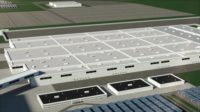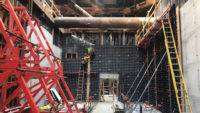As the U.S. military continues to build up its presence in Guam, the Navy selected seven contractors March 14 to compete for construction projects under a five-year indefinite quantity/indefinite delivery contract worth up to $2.5 billion.
Of the nine contractors that submitted under the contract, Naval Facilities Engineering Systems Command (NAVFAC) Pacific selected Guam-based Black Construction-Tutor Perini JV; Core Tech-HDCC-Kajima LLC, also based there; Concord, Calif.-based Gilbane Federal JV; Watsonville, Calif.-based Granite-Obayashi 2 JV; Hensel Phelps Construction Co. Honolulu; and Carlsbad, Calif.-based RQ Construction LLC to compete for the work, according to the U.S. Dept. of Defense contract award notice.
About 80% of the work is due to be performed in Guam, and smaller portions will be done in the Northern Mariana Islands, Hawaii and elsewhere in the NAVFAC Pacific area of operations, the Navy says.
Officials also awarded the first task order under the contract to Granite-Obayashi for a $126.1-million project to build facilities for two infantry battalions, including an auto shop, an electrical/communications building, roads and other facilities in Finegayan, Guam, according to the contract notice. The project is expected to complete by December 2025.
Additional design-build and design-bid-build task orders may include construction of barracks, administrative offices, medical facilities, warehouses, ranges, roads, bridges and other infrastructure, according to the original solicitation notice.
The contract comes on the heels of NAVFAC awarding a $2.8-billion task order to Honolulu-based Dragados/Hawaiian Dredging/Orion JV under a separate IDIQ contract for construction of a replacement dry dock at Pearl Harbor Naval Shipyard and Intermediate Maintenance Facility in Hawaii. That is part of the Navy’s Shipyard Infrastructure Optimization Program, a 20-year, $21-billion plan to modernize infrastructure at Pearl Harbor and other U.S. Navy shipyards in Puget Sound, Wash.; Norfolk, Va.; and Portsmouth, Maine.
The U.S. military has been moving more resources to the Pacific as officials look to meet what Defense Secretary Lloyd Austin terms “our pacing challenge” from China.
President Joe Biden’s 2024 budget request includes $9.1 billion for the Pacific Deterrence Initiative, a 40% increase from this year that Austin says represents the largest-ever request for the program focused on advancing U.S. military capabilities for the region.
Speaking at a military contracting conference last month, Navy Secretary Carlos Del Toro said China is in the midst of a push to modernize its military and expand its navy from 340 ships today to 440 ships by 2030.
“[China’s] navy is conducting active, aggressive maritime activities in the South China Sea that have the potential to undermine our system of international law, including the freedom of the sea, a foundational U.S. interest,” Del Toro said.
In response, officials say the Navy has shifted a greater share of its fleet to the Pacific. A Congressional Research Service report from last year projects it will include about 290 battle force ships by the end of 2030.
The buildup in Guam has also been spurred in part by plans to shift thousands of Marines from Okinawa, Japan, to the new Marine Corps Base Camp Blaz in Guam. The Corps reactivated the base this year, and it remains under construction.
As ENR previously reported, the U.S. military has awarded more than $1 billion in contracts for construction in Guam recently, mostly for Camp Blaz. Last month, NAVFAC awarded another IDIQ contract worth up to $100 million to Honolulu-based MDPAC JV for architect-engineer services related to structural, waterfront and other projects in Guam and other Pacific facilities.





Post a comment to this article
Report Abusive Comment